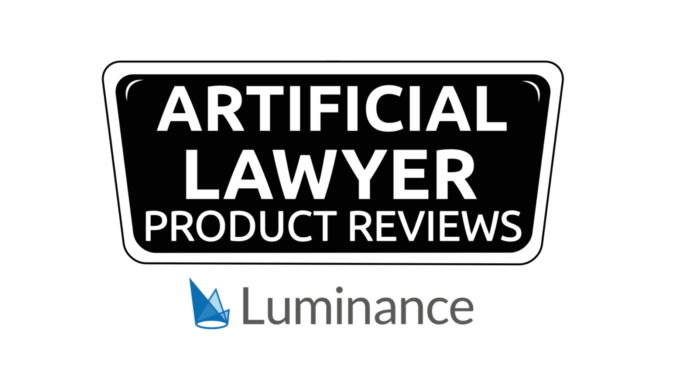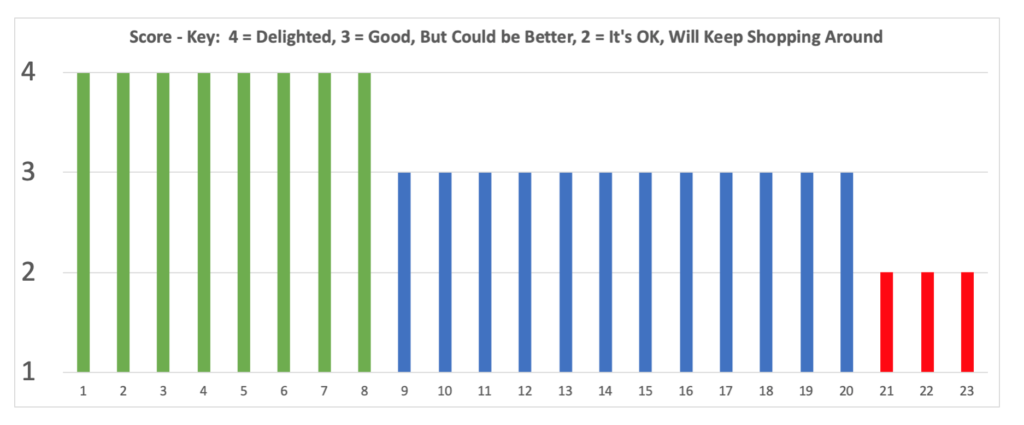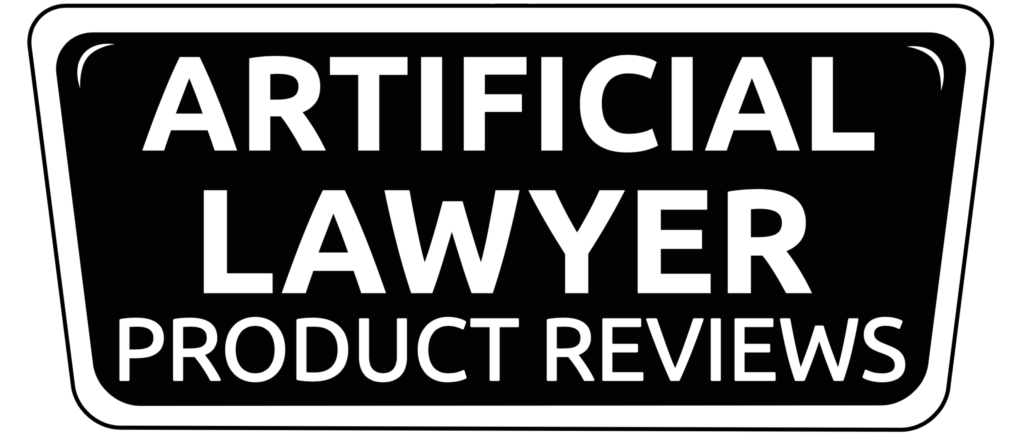
And now, here is Part Two of the Artificial Lawyer Product Review for legal AI doc review and analysis company Luminance. This second part of the review follows directly on from Part One.
The key areas covered here are:
- Overall star rating;
- Question 4 – ‘How easy has it been to use & what was product support like?’
- Question 5 – ‘Given its price, has this product delivered value for money?’
—
Luminance Product Review – Part Two
Overall Star Rating
Artificial Lawyer received 23 star ratings from customers of Luminance (see table below).

Scoring was between 4 as highest, and 1 as lowest, in terms of the overall view of the product, with most customers giving a 4 or 3 star response.
Three customers that responded to the survey gave two out of 4 stars, which indicated they would likely keep shopping around. Eight out of the 23, or approximately one third said they were ‘delighted’ with the product. And, 12, or just over half, gave the product a three star rating, meaning it was ‘good, but could be better’.
The average overall score for Luminance was therefore: 3.2.
For Kira Systems, a well-known rival in the same category, that Artificial Lawyer conducted a product review of in December 2018, using a similar star system (although with different main questions), the overall average score was 3.6. Naturally, both scores should only be seen as indicative of a sample of users at a particular point in time.
Commentary: Any average score of 3 or higher shows that customers – at least those that responded – have a generally positive view of a product. This also is reflected in the written commentary.
Clearly a star score that reflects user sentiment is not an exact science, but it at least gives us a general indication of how users feel about the product. In which case, we can safely say that although a small number felt they want to keep looking for an alternative provider of this type of product, the majority of the sample appear committed to using Luminance over the long term.
Question 4 – ‘How easy has it been to use and what was product support like?’
- The user interface is exceptionally intuitive. This was one of the key reasons why we chose Luminance. It says something about a platform when lawyers (notoriously slow to adopt new technology) can be up and running in the system in a matter of minutes without needing lengthy training sessions.
- The product becomes easier to use the more you use it. It has a lot of functions so measured training with users is needed.
- Product support is responsive and they have invested in having regular catch ups with us. [But] they could listen to and seek user feedback in a more open way, perhaps with a shared user portal where people suggest ideas/features and users vote on which they would like to see.
- Luminance is relatively easy to use and the support has been generally very good. Luminance have been willing to come onsite (both in the UK and other countries) to provide support and training on live deals.
- It has been good to use, of course there are some hiccups, but the overall use has been a good experience. You feel the product is young, as support is a bit off at times, but again this is something that has improved over time.
- Very intuitive to use and the product support is great, always ready to help us out.
- Very user friendly and great product support.
- Luminance is easy to use as a tool and provides practical solutions for effective due diligence reviews. The visualised view gives an overview of the materials.
- There is quite a learning curve and new skills need to be developed but the product support is excellent.
Commentary: The number of responses saying the product is ‘intuitive’ and the support is very good dominated this survey sample. Although there was a small pocket of critics, overall it’s clear that Luminance has worked hard on the UI/UX, has understood how lawyers work, and has put in place the investment needed to create a solid and available support team.
Understandably, some software companies try to minimise customer support in order to maximise short term profits, as having a large team of support staff can be a considerable cost to any business. That Luminance has put resources in here shows commitment to its customers.
Also very clear is the fact that the customers, except a very small minority, really appreciate this effort and are keen to point it out. The comment above about Luminance being so intuitive it was very easy to get lawyers to use it – and in just ‘a matter of minutes’ – was a case in point.
It’s no small feat to create a piece of software that has so much complexity in terms of machine learning behind it, but with a front end that people find very easy to use. Its dashboard that shows you very clearly what is in your document stack is an example of its design approach.
In short, whatever challenges Luminance may have, its front end product design and customer support are generally not among them.
Question 5 – ‘Given its price, has this product delivered value for money?’
- Good value for money in particular given the ‘pay as you use’ model adopted by Luminance.
- As is it a ‘pay as you use’ type of service, the cost has not been high.
- It has been relatively inexpensive to use for initial pilots / R&D and this has been good to enable us to explore use cases and provide very relevant demos to legal teams. However, they have released other very similar modules to Diligence (e.g. Compliance) with functionality we could use, but the costs (large project upload fee) are prohibitive and slightly frustrating that they release similar products rather than investing in one super product.
- Pricing model is very attractive. We believe the product provides great value.
- Generally yes, although it is important to actively manage and monitor usage and close down or archive sites when not actively in use to avoid large costs.
- Yes, without a doubt.
- We strongly believe the product will deliver value for money once it is successfully implemented.
- Not yet, but with more use we anticipate it will deliver value for money in the future.
- Not entirely for now.
- Our concerns with regards to getting the most of the tool are related not to its costs but to successfully change the way we work.
- What sets Luminance apart is that they offered a free trial. We really liked the ‘try before you buy’ approach as it made it easy for us to then demonstrate the return on investment and gain buy-in at all levels of our business.
Commentary: When it comes to price and value, the responses were more complex. One group saw a great pricing system, which is a pay as you use, or ‘pay as you go’ as mobile phone users may call it. Many of these also saw the value – and that perhaps is because, put simply, when used moderately Luminance is not an expensive tool to have.
For another group, mainly those that use Luminance regularly, there was also praise, but in addition some frustrations around the pricing of separate modules to carry out different types of work, as well as around the price of storage of large amounts of data that had created higher costs than they had liked.
A third group, which was a clear minority, didn’t see the value despite the flexible pricing. These tended to be the customers that had not really been able to use the system, whether because of language barriers or other reasons. Hence, their response that they didn’t see great value could be expected.
Overall, is Luminance value for money? The answer seems to be: yes. Light users liked the flexible pricing that didn’t hit them with a big annual licence fee and allowed them to test it and use it only for certain matters. More heavy users, although they had some concerns, also saw the value.
Overall Conclusion to the Luminance Product Review
Taking into account all five questions and the star rating, as well as the responses from Luminance to several questions put to the company, the overall view of the product, at least from Artificial Lawyer’s perspective is as follows:
- Luminance has rapidly established itself as a key part of an increasingly important legal tech category – doc review and analysis – in a very short time, and gained dozens of clients around the world, although those clients’ use levels of the system clearly vary from very light users to very regular users.
- It has gained significant law firms and other types of legal business, and corporate legal teams, as clients, stretching from the US and UK, across the elite firms of Europe, to the leading firms of APAC. While such firms may have been initially overcome by the excitement of the legal AI wave that hit the market in 2017/2018, these are generally sophisticated businesses and would not still be using Luminance in 2019 if it didn’t deliver value.
- In fact, among those firms that did use Luminance regularly the view from the responses was that the goal now is to try and expand usage as much as is possible across the business. That again is a sign of faith in the technology.
- However, going back to use levels, (see Part One), these are uneven across the sample of customers this review saw responses from. This ranged from firms where they were genuinely using it for most of their significant M&A due diligence tasks, for example; to firms using it regularly, but not really continuously; to firms that in effect were still very much in pilot mode, even if they were using it occasionally on live client matters.
- Part of this is down to the speed at which Luminance has grown and won clients, as well as its fee system. If you make it relatively inexpensive to have the software, then barriers to becoming a customer are low. But, that doesn’t mean people will use it. More expensive systems, and/or ones with very large annual licences, force firms to make sure they have built a business case for the software and will make sure to use it, before they move forward. That may mean less customers, but is more likely to result in higher usage levels. (Of course, some firms also from time to time buy in expensive software and don’t use it either….)
- Ultimately, Luminance has chosen a ‘flexible price/maximise client numbers/hope they use it’ strategy. It has said as much in a statement to Artificial Lawyer when asked about use levels. The company said: ‘Due to the partner-led structure of most law firms, certain teams will begin using Luminance before others. We have early-adopters of Luminance that have implemented firm-wide mandates to use our technology on every deal and others who take longer to encourage their teams to use it. Our land and expand business model is built with this in mind.’
- Beyond use levels is the more basic question: is Luminance any good at what it does? The simple answer is: yes – at least from what the responses said.
- Where the product was faulted it was mainly because of A) language barriers – See Part One, and B) not always connecting to the data rooms the clients wanted to use.
- Customers like it overall, they have found multiple and creative ways to use it. They liked its UI/UX. They liked its support. They – generally – like its pricing model.
- Overall then, this is a successful product.
- Where there does seem to be some kind of ongoing uncertainty is around use of non-English languages. This may be all down to vendor-to-client communication issues, but some law firms clearly believed Luminance would be effective in their language in terms of helping them to review and analyse contracts that are not in English – and then they failed to get to the outcome they wanted.
- Maybe the language ‘misunderstanding’ was the clients’ fault and they didn’t put the time in to train, whether ‘on the job’ or otherwise, the system sufficiently to help them. However, some of Luminance’s marketing could be interpreted as meaning that documents in any language can instantly be reviewed with little or no effort on the part of the law firm. Although ‘on the job’ training of Luminance while reviewing foreign language documents may indeed deliver value, it’s worth noting that one major firm, outside of the Anglophone world, said it had spent ‘three years’ working with the system to get it familiar with their national language and are only planning on using it for live matters next year. In this respect there is clearly some confusion being created by the marketing, and that needs to be addressed.
- So, there you go. Ultimately it’s now up to you – if you feel inclined – to see the demos, run pilots, compare the system to other leading companies in the market, gather data on performance and feedback from the people who use the software, and then come to your own conclusion.
Artificial Lawyer hopes this review was useful and that by sharing this real world feedback you have gained some insights into Luminance.
We would also like to very much thank everyone who took the time to contribute responses. Your input is truly appreciated.
